At least one person was killed and two others were injured on Thursday in central China’s Hubei province after a Chinese military jet crashed into a residential area during routine training, the state-run China Global Television Network (CGTN) reported.
A Chinese People’s Liberation Army Air Force (PLAAF) J-7 fighter jet crashed during a training exercise on the morning of June 9 in the Hubei city of Laohekou, damaging several civilian homes.
“The pilot parachuted from the plane and was taken to hospital for examination and treatment along with two injured members of the public,” China Central Television (CCTV)’s military channel reported.
Video footage of the crash site published online by the South China Morning Post (SCMP) showed the extensive impact and fire damage to a residential compound in Laohekou. Smoke billowed from a hollowed-out residential block as local firefighters attempted to put out persistent flames. The video also appeared to show the doomed jet’s fighter pilot sitting near the crash site shortly after he ejected from the aircraft.
The state-run CCTV said the cause of the PLAAF accident and whether it produced further casualties remained unknown at press time on June 9.
“The J-7 fighter jet was developed in China in the 1960s and is designed mainly for short-range air-to-air combat. Its production was suspended in 2013 and a derivative aircraft is now mainly used for pilot training,” according to the SCMP.
“There have been several other cases of fighter jets crashing during training flights in China,” the Hong Kong-based newspaper recalled on Thursday. “In 2015, a Chinese air force pilot parachuted to safety moments before his aircraft crashed into a hillside. Two years before that, a military pilot died when his fighter jet crashed during night training in eastern Zhejiang.”
China suffered its deadliest civilian air incident since 1994 on March 21 when a China Eastern Airlines jet crashed into a mountain in southern China’s Guanxi autonomous region, killing all 132 people on board. The Civil Aviation Administration of China (CAAC) said on April 20 that it was still investigating the cause of the tragedy, though reports by the Wall Street Journal (WSJ) and Reuters in May suggested the plane may have intentionally nose-dived into the Guanxi mountainside.
“The Boeing 737-800 was cruising at high altitude when it suddenly pitched into a near-vertical descent, plummeting into a mountain at extreme speed. Data from a black box recovered in the crash suggests inputs to the controls pushed the plane into the fatal dive,” the WSJ reported on May 17, citing unnamed individuals “familiar with U.S. officials’ preliminary assessment of what led to the accident.”
Reuters reported on May 18 that investigators of the China Eastern Airlines incident “were looking at whether the crash was a ‘voluntary’ act involving crew inputs to the controls,” citing an anonymous source.

COMMENTS
Please let us know if you're having issues with commenting.